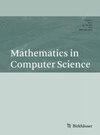Concept of a System Using a Dynamic SWOT Analysis Network for Fuzzy Control of Risk in Complex Environments
IF 1
Q2 MATHEMATICS, APPLIED
引用次数: 3
Abstract
The paper advocates a new concept for risk control that makes up one organic closed loop feedback system, with the following stages: 1) the evaluation of the positive and negative features of situation under investigation through strengths, weaknesses, opportunities, and threats (SWOT) analysis, 2) the determination of the level of fuzzy risk concealed in this situation (using RISK evaluation), and 3) the proposal of leverage, recommendations, or actions (through LEVERAGE aggregation) enabling the improvement of target performance. Useful fundamental approaches, definitions, and particularities of this concept concerning SWOT, RISK and LEVERAGES are examined, and for the first time the network type called here the fuzzy SWOT map (FSM) is introduced. This newly proposed instrument appeared as a result of a natural extension of fuzzy cognitive maps paradigm enhanced by dynamic computing with words (CWW) elements and possibilities to use the explainable artificial intelligence (XAI) in the form of fuzzy inference rules. The concept serves for development of functional organization of control systems of complex and dynamically interacting projects or situations and for implementation of adequate set of tools satisfying the concrete system’s requirements. The results of conceptual modeling and the confirmation of the vitality of the approach are presented based on the simplified example of a risk-control system case covering three interacting projects in a complex environment of city development.基于动态SWOT分析网络的复杂环境风险模糊控制系统概念
本文提出了一种新的风险控制概念,它构成了一个有机的闭环反馈系统,分为以下几个阶段:1)通过优势、劣势、机会和威胁(SWOT)分析对所调查情况的积极和消极特征进行评价,2)确定该情况中隐藏的模糊风险水平(使用风险评估),以及3)提出能够改善目标绩效的杠杆、建议或行动(通过杠杆聚合)。本文考察了SWOT、RISK和leverage这一概念的有用的基本方法、定义和特殊性,并首次介绍了这里称为模糊SWOT图(FSM)的网络类型。这个新提出的工具是模糊认知地图范式的自然扩展,通过单词动态计算(CWW)元素和以模糊推理规则形式使用可解释人工智能(XAI)的可能性得到增强。该概念适用于复杂和动态交互项目或情况的控制系统的功能组织的开发,以及满足具体系统需求的适当工具集的实施。基于一个风险控制系统案例的简化示例,在复杂的城市发展环境中涵盖三个相互作用的项目,给出了概念建模的结果,并证实了该方法的生命力。
本文章由计算机程序翻译,如有差异,请以英文原文为准。
求助全文
约1分钟内获得全文
求助全文
来源期刊

Mathematics in Computer Science
MATHEMATICS, APPLIED-
CiteScore
1.40
自引率
12.50%
发文量
23
期刊介绍:
Mathematics in Computer Science publishes high-quality original research papers on the development of theories and methods for computer and information sciences, the design, implementation, and analysis of algorithms and software tools for mathematical computation and reasoning, and the integration of mathematics and computer science for scientific and engineering applications. Insightful survey articles may be submitted for publication by invitation. As one of its distinct features, the journal publishes mainly special issues on carefully selected topics, reflecting the trends of research and development in the broad area of mathematics in computer science. Submission of proposals for special issues is welcome.
 求助内容:
求助内容: 应助结果提醒方式:
应助结果提醒方式:


